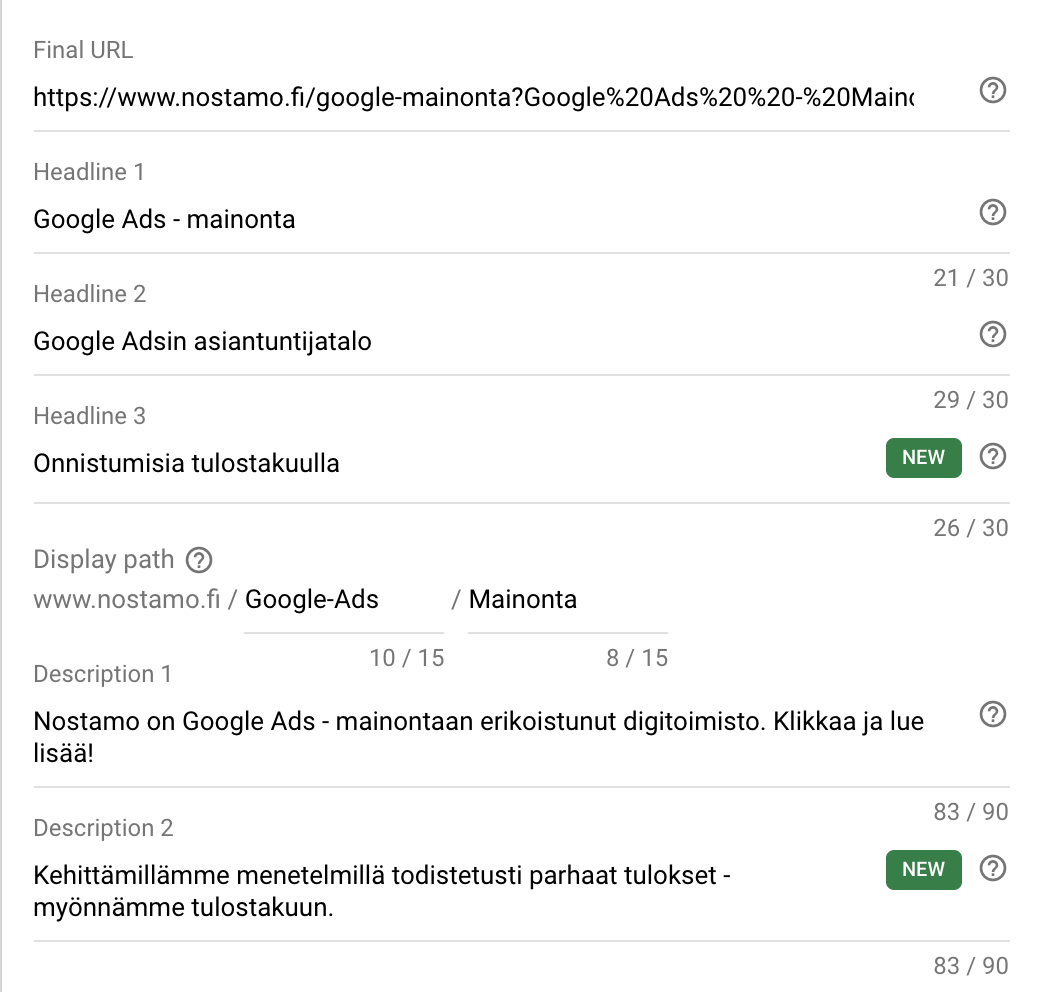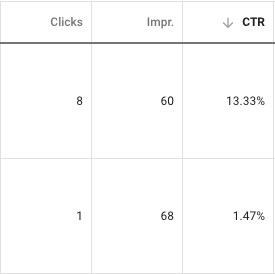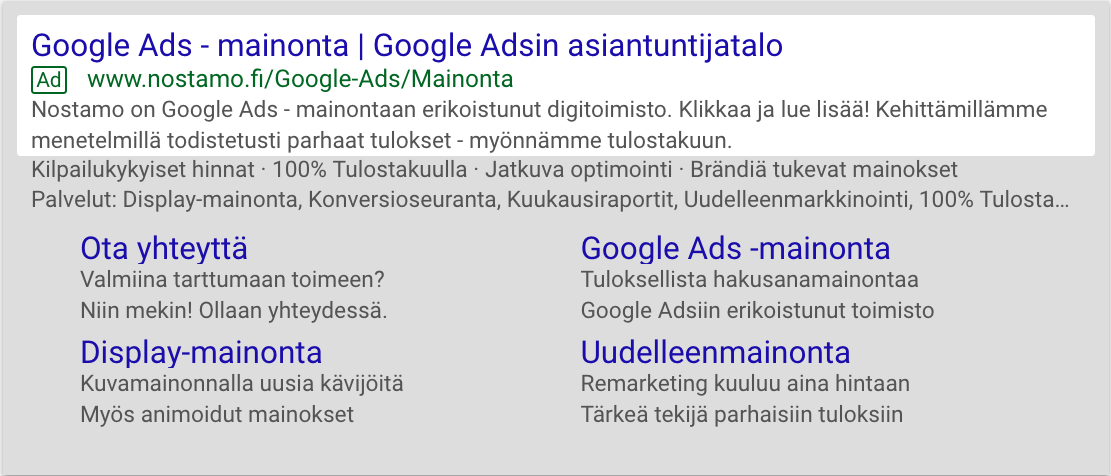A well-constructed Google ad is a somewhat unique case in terms of marketing: due to Google's complex algorithms, the ad needs to be tailored for both the machine and the human reader. Additionally, character limits for ads present their own challenges for writing ad copy.
In this article, we'll break down a good Google ad into its components and see what it entails. We'll be discussing traditional search ads, which were replaced by responsive search ads in the summer of 2022. However, the same principles apply to both types of ads.
Stand Out with Compelling Ad Copy
Writing ad copy requires a good deal of creativity, as the text needs to stay within character limits while still piquing interest. It's always an uplifting situation when you come up with an incredibly compelling headline for your ad, only to realize during the writing phase that it contains 31/30 characters.
The different sections of the ad and their maximum character counts are as follows:
Headline (maximum 30 characters)
Headline (maximum 30 characters)
Headline (maximum 30 characters)
Description (maximum 90 characters)
Description (maximum 90 characters) Paths or URL addresses (maximum 15 characters per path)
When writing ad copy, it's important to note that the 3rd headline and 2nd description may not always be displayed. Therefore, critical information should not be included in these sections.
The displayed path or URL address in the ad can be written freely. This means you can use any text as the address; it doesn't have to be an actual web address. The correct landing page for the ad is defined in settings elsewhere.
Below is an example of our own ad:

When creating a campaign, this ad will look like:

It's recommended to create at least two different variations of ad copy and find the most effective text through A/B testing. By testing, you avoid making unnecessary assumptions and can draw conclusions based on data.
Below is an example of an A/B test conducted for our latest client. The ads differ only in the H2 headlines.

One of the variations has a 807% higher click-through rate! The test's p-value is 0.01, so the test is statistically significant (the commonly used threshold for significance is 0.05). The difference is so substantial that conclusions can be drawn from such a small number of impressions (ad displays).
The lower Google ad can be removed, and a new variation can be created from the top-performing ad. This way, the efficiency of the account can theoretically be increased indefinitely.
Address the Searcher's Intent
Search engines are used for one reason: to find information. The purpose of search engine advertising is to assist in this information retrieval.
You create the most value by making highly specific ads. Separate ads should be created for all important keywords. The biggest mistake is to create only one generic ad that is shown for all possible keywords.
For example, a Tampere-based accounting firm is sought with keywords like:
Accounting firm Tampere
Bookkeeping Tampere
Electronic financial management
A separate ad is created for each of these. How likely would you be to click on a generic ad with the headline "Meikäläinen Accounting Firm | Professional Accounting Firm" if you're looking for information on electronic financial management? While electronic financial management might be Meikäläinen's main service, the searcher wouldn't know unless it's mentioned in the ad text. For someone searching "Accounting firm Tampere," it's important to inform them about Meikäläinen's office in Tampere.
By addressing the searcher's intent, you can increase the ad's click-through rate. This raises the ad's quality score and reduces the cost per click. Through these mutual effects, the overall effectiveness of the ad account improves.
Utilize Extensions
It's advisable to use all applicable extensions in the ad. With extensions, various additional information can be added to the ad, which is displayed alongside it. This increases the ad's click-through rate.
The image below illustrates the benefits of extensions. The gray area was created with extensions:

As you can see, the extensions have expanded the ad size by almost three times!
Extensions provide a lot of additional information to the ad. In the example ad, the following extensions are used:
Callout Extension, which can showcase service promises or similar information.
Sitelink Extension, which adds extra links to the ad.
Structured Snippet Extension, which can highlight more detailed features of the service or products.
Extensions add free value to your ads, so this should definitely be utilized.
Use the Right Landing Page
The landing page is the page to which a visitor who clicks on the ad is directed. A good landing page is an extremely important part of a successful ad campaign. While the goal of advertising is to drive traffic to the company's website, the final conversion rate is largely determined by the landing page.
The two most important tasks of the landing page are as follows:
The visitor must find the information they're looking for on that page.
Don't direct the visitor only to the homepage. Choose a landing page that addresses the topic the visitor searched for on Google.
People's patience online is low, so the visitor must find the information they're looking for as quickly as possible. An airy structure allows the site to be quickly scanned, and important keywords in the text can be identified.
The site must inspire trust.
No one does business with an untrustworthy company. On the internet, trust is built through good functionality, expert text, and an appealing appearance.
Among functionalities, I would highlight responsiveness: about half of all traffic is from mobile device users, so the site must be mobile-friendly. It also needs to load quickly so the visitor doesn't close the site out of impatience.
In Conclusion
A good Google ad consists of many different components. It's particularly important that the ad addresses the searcher's incentive, which is the intent behind the search. What does the searcher want to find out? A good ad assists the searcher by providing them with exactly the right information.
An effective ad stands out from other ads with compelling and interesting text. By using extensions, additional information and more clickable surface area are added to the ad, which also helps improve its effectiveness. The likelihood of conversion, such as making contact or completing a purchase, is particularly influenced by using the right landing page: the visitor must be directed to a page that addresses the topic they searched for.



